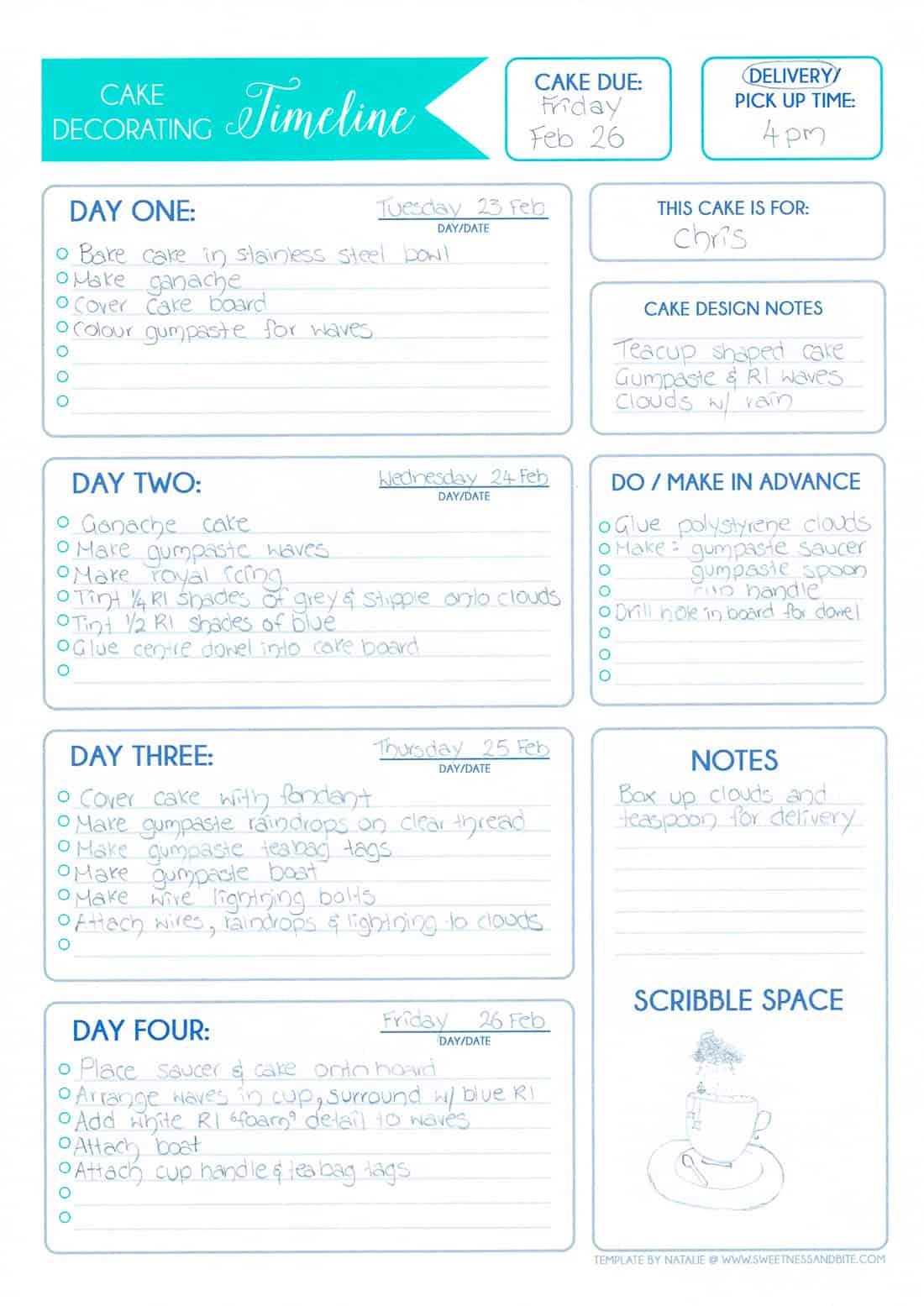How To Write Your Own Cake Decorating Timeline
This post may contain affiliate links to products I recommend. I receive a small commission at no cost to you if you make a purchase using my link.
A simple guide on how to write your own cake decorating timeline so you can plan each step of your cake. Includes a free printable cake decorating timeline template!

Oh to be organised.
I feel like I’m the kind of person who should be organised. I like to know what is happening and when, and I love lists. Seems like I should be really onto it, right? I mean, lists. That’s organisation in a nutshell, is it not?
Unfortunately, I’m also a bit of a klutz, and I tend to attract mishaps like pretty girls attract boys. Basically, mishaps are all over me with their desperate, groping hands.
But no matter the disasters that might be imminent, there is one thing that I always do before I start any cake. I sit down with a cup of tea and write up a cake decorating timeline of what I want to do on each day. (The tea isn’t compulsory, it just helps me think. The timeline is the important bit.)
Even if you’ve only just started cake decorating, you’ll probably know by now that for even a simple decorated cake, it’s darn hard to do everything in one day. Sure, it can be done, but it’s a lot of rushing and running around.
The day that I realised that professional cake decorators don’t generally do it all in one day, it was like a weight had been lifted. The day I heard about the “3 day cake decorating timeline” I could hear chubby, frosting-covered angels singing.
the 3 day cake decorating timeline:
The basic premise of the three day cake decorating timeline is this:
Day 1: Bake the cake/s, and make your ganache
Day 2: Cover the cake/s in ganache and leave overnight to set
Day 3: Cover the cake in fondant, and decorate
I like to stretch it out to a 4 day timeline, which adds in what I affectionately like to call a “mess up day”. Ok, I won’t lie, that’s not what I actually call it. I call it something that starts with ‘f’ and rhymes with… well, you can probably guess some things that it rhymes with. But my mother has to proofread this for me like she does all my posts, and I save my swear words up for when I really need them and can handle the lecture.
(Because I’m a grown-up like that.)
The joy of a 4 day timeline is that you get a whole day to spend decorating the cake, after baking and covering them on days 1-3.
Or, if something does go wrong earlier in the week, you have a day up your sleeve if you need it to re-bake/re-cover/re-sit-yourself-down-and-get-it-together.
If you’re using a long-lasting cake (you can read more on that below), then you can stretch this timeline out even further if you want to. But for the purposes of this post, we’ll mainly be talking about 3 and 4 day timelines.
The whole point of this post is give you the information and tools to write your very own cake decorating timeline, based on your cake design, and the time you have available to make the cake. And, I’ve designed a printable timeline sheet, so you can plan it, see it, and do it.
So where do you start when planning your own cake decorating timeline?
Up there in that 3 day timeline, I mentioned ganache. This basic timeline is usually based on a cake that is coated in ganache before fondant.
Ganache is a miracle worker in that it seals a cake to keep it fresh and moist, without needing to be refrigerated. This is why I pretty much use ganache for every cake I make. I don’t enjoy having to refrigerate the cake, get it to room temperature before covering it in fondant (or covering a cold cake and dealing with condensation and sticky fondant as the cake warms up).
I told you earlier about my habit of screwing things up and stressing, so I generally try to do anything possible to limit that stress. But, that’s not to say you can’t use the timeline with buttercream, as you’ll see below.
One of the most important things to consider when planning a timeline is the cake and filling recipes you are using.
How Long Do Cakes Last?
There are some cake recipes, like dense chocolate mud cakes, that keep exceptionally well, and in fact, improve in flavour and texture when ‘aged’ for several days. A traditional fruit cake covered in almond icing and fondant can be worked on for weeks. Some more delicate cakes like sponge cakes and butter cakes often don’t taste so good after several days, and are best made closer to the day on which they will be served.
While I’d love to be able to tell you exactly how long every kind of cake will last, the only way you can know for sure is to test each of your recipes yourself.
Similarly, some cake fillings (like my beloved chocolate ganache) are stable at room temperature for several days. Others, like some buttercreams, may need to be refrigerated depending on their ingredients, and others like cream cheese frosting always require refrigeration.
I find that an American-style icing sugar buttercream is fine at room temperature over a three-day timeline, but this will depend on the room temperature, and you’ll need to use your judgement and the food safety requirements for where you live.
You’ll need to take all of this into account in your timeline.
Things to think about to help you plan your timeline:
How many cakes do you need to bake? Can you bake them all one day? Do you need to bake and freeze cakes in advance? If so, what day will you need to pull them out of the freezer to defrost?
If you’re making several cakes, try to think about which ones you can bake together (if they fit in your oven and bake at the same temperature) and what cake pans you have (are you baking different cakes that need to be the same size, and how many cake pans of that size do you own?
If you only have one pan, then make sure you factor in the time that the first cake will need to cool before you can remove it and reuse the pan.)
Some decorators like to bake and freeze their cakes early in the week and defrost them for decorating.
I personally prefer not to freeze my cake before decorating, especially if I’m making them for someone else. I like for people to be able to freeze the leftovers if they want, and you can’t freeze a cake twice. But if freezing is something you need to do to make your timeline work, and if the cake doesn’t need to be able to be frozen later, then it could be a good option for you.
How long does the cake you are baking last? Is it a mud cake that will last for at least several days once covered, or is it a more delicate cake like a sponge or butter cake that won’t last so long?
If it’s a long-lasting cake, then a 4 day timeline is suitable, if not, best to stick with 3 days.
What kind of filling are you using? Is it a filling like ganache that is stable at room temperature, or will it require refrigeration?
If it’s ganache, then it will keep well for a 4 day timeline, if it’s buttercream then 3 days may be best.
If it’s a filling that needs refrigeration, make sure you allow for chilling time in your timeline (and maybe add “making space in the fridge for the cake” to your list of tasks, if your fridge is anything like ours 😬).
What decorations are going on the cake? Do they need to be made in advance and given time to dry? Or do they need to be made fresh and placed directly on the cake?
Decorations that need to be made in advance can be started before the cake timeline starts, or if they only need a few days to dry then they can be made on Day 1.
If the decorations need to be put on the cake while they’re still soft, then they are best made the day that you’re decorating the cake. If they’re soft decorations that will take a long time to place/pipe (like fondant ruffles, or intricate piping details) then make sure you give yourself enough time to complete them.
For more information on making cake decorations in advance, check out my How to Store Fondant Decorations post.
Do you have any time restrictions in the lead up to the cake being due? Do you need to adjust your timeline around work/family/other commitments? Can you make changes to give yourself more working time, like making decorations in advance, freezing cakes, or using longer-lasting cakes and fillings?
Keeping all of these things in mind is very important when decorating. I see so many hobby cake decorators panicking that they don’t have enough time to complete a cake after being at work all day and spending time with their kids, and they have to try and cram in 12 hours of decorating into 4 hours after the kids are in bed.
Hell, I don’t even have kids but I still need to find ways to work decorating around other things. You need to be realistic in what you can and can’t achieve in the time you have available.
Make sure you think about this before you even agree to make a cake. If it’s a very detailed cake that is going to take a lot of time, and you don’t have that time, then you need to seriously consider whether taking it on is a wise idea.
Likewise, if you’re making a cake for a client (or a friend) then make sure they are also realistic (and they probably won’t know that it’s not realistic because they don’t make cakes, so you may need to explain why it’s not).
If they’re asking for a five-tier cake with very intricate piping on each tier, but they want sponge cake filled with fresh whipped cream, then you’re probably not going to have nearly enough time to pipe the decorations while keeping the filling fresh. Don’t be scared to tell people that cake flavours may be limited depending on the decoration required.
So now you have all that information, you can use it to fill in your own cake decorating timeline.
It can help to write a quick list of each task you’ll need to complete for a cake, and then use that to fill in your timeline. I tend to start with the main things (baking the cake, making the ganache, ganaching the cake, applying fondant) and then spread other smaller decorating jobs that don’t have to be done on any particular day throughout the timeline.
If you’d like to download my printable timeline sheet, then you can do that at the bottom of this post. It has spaces for four day’s worth of tasks, which you can check off as you go.
Cake Decorating Timeline

Right up the top is space for the day the cake is due and delivery/pick up time. Then there are spots for you to jot a few notes about the cake design and list things that can be made or done in advance.

There’s also a spot for general notes or reminders and a scribble space where you can do a quick sketch of the cake design if you haven’t already done (or don’t need) a full sketch.
Or you could just draw random pictures of cats. I won’t judge.

To give you an example, I’ve written a cake decorating timeline for my “Storm in a Teacup” cake that I made a few years back.

I’ve been a bit more detailed in this than I usually would, as I tend to use my own dodgy shorthand notes for my own timelines, so I’ve written it out properly so y’all know what I’m talking about.
You can be as detailed or brief as you like in your cake timeline, as long as you know what you’re on about. (Excuse my handwriting, it’s average at the best of times but my hand tremor decided to turn up the day I wrote this. Thanks, hands. Really, thanks.)

(The planner will open in a preview page, just right-click and choose “Save As” to save to your computer.)
So there you have it, how to write your own cake decorating timeline. Unless you prefer to wing it. Are you a planner, or a fly-by-the-seat-of-your-pants kinda cake maker?
As always, any questions, feel free to ask ‘em in the comments.
~Natalie
xx






